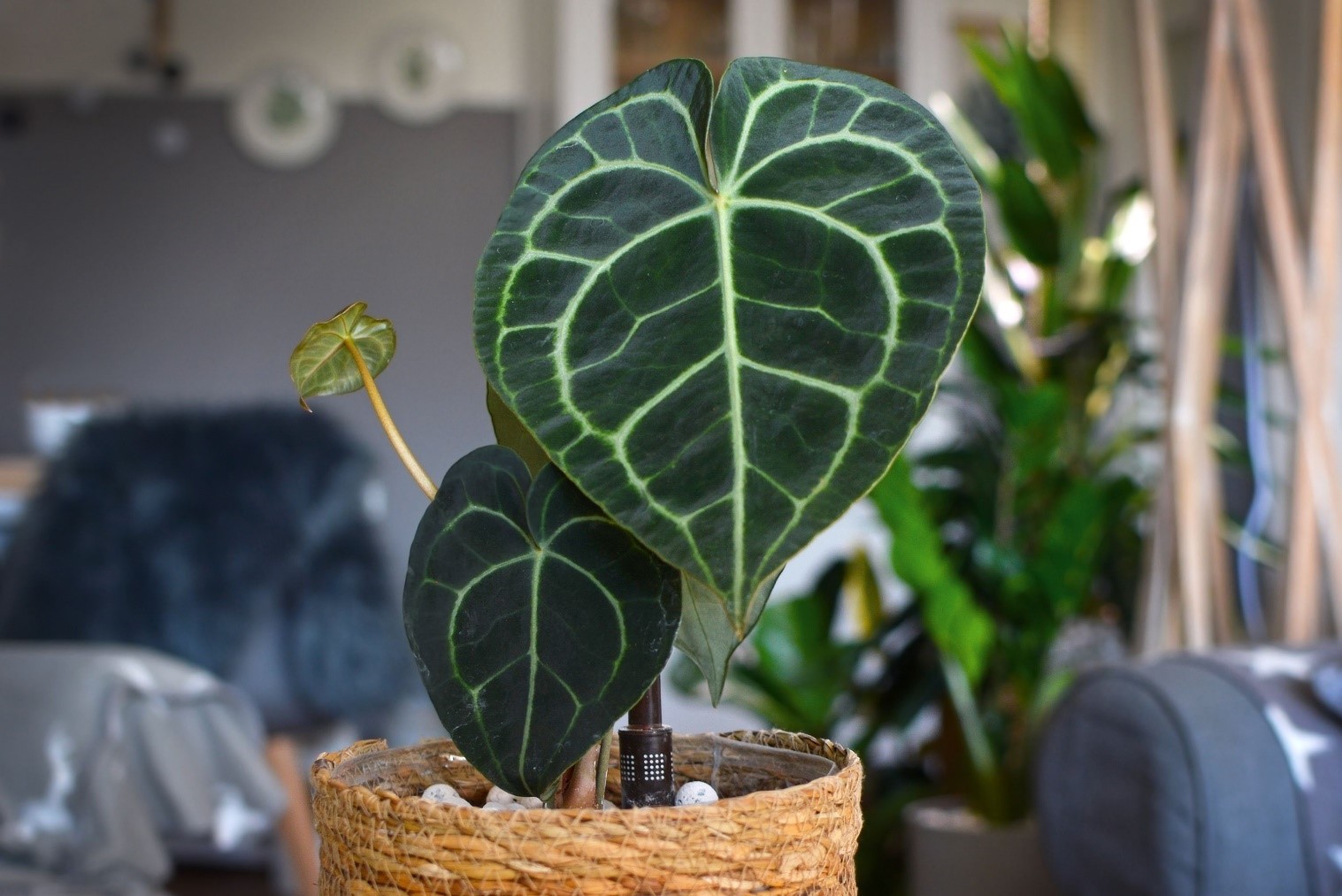The Anthurium Crystallinum is frequently confused for the Anthurium Clarinervium and vice versa due to their similar appearance and behavior. The two look strikingly alike, each being extremely sensitive to humidity and light.
The main differences between Anthurium Crystallinum vs Anthurium Clarinervium: the shape of the leaves, the colors of the berries and the speed of growth. The Clarinervium has heart-shaped, broader dark green leaves large orange berries and grows slower than its cousin. The Crystallinum has narrower, elongated bright green leaves, its berries are white to violet, and it’s a fast grower.
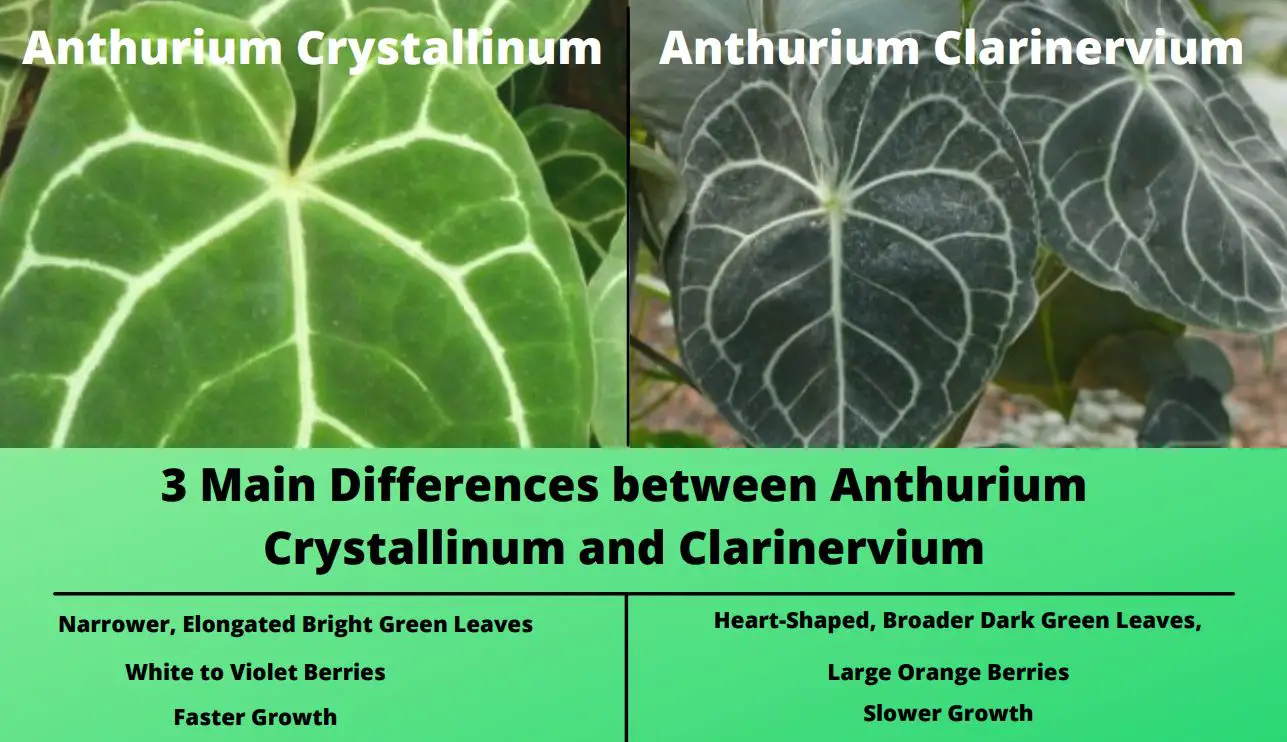
What is Anthurium Crystallinum?
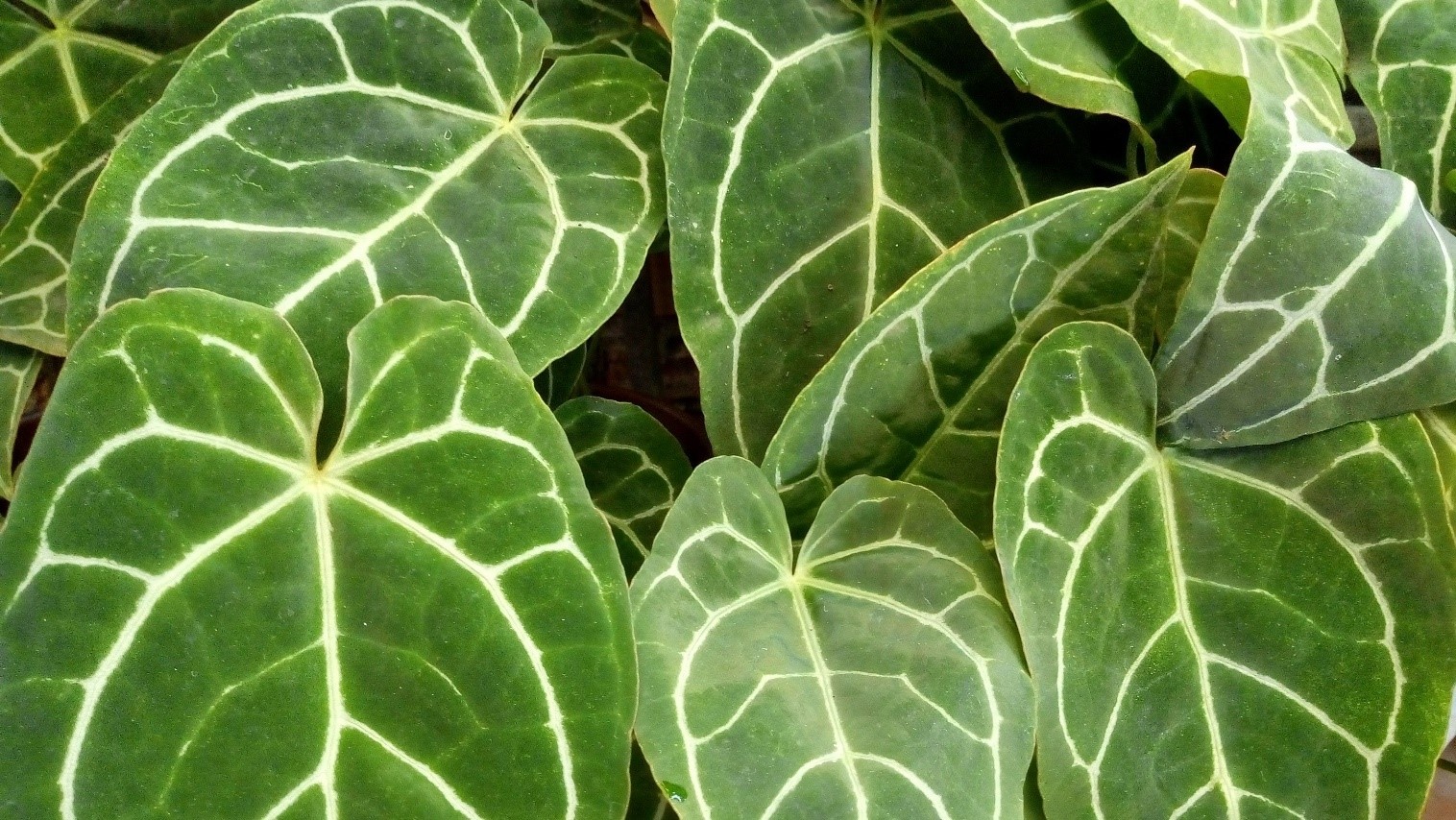
Anthurium Crystallinum is a Panamanian plant that grows up to 90 cm, or 35.3 inches, or just under 3 feet tall, and has enormous, green, oval leaves.
It’s also called a Crystal Anthurium plant, the second most common term.
Widely cultivated as a houseplant, it’s thought to be one of the easier plants in terms of maintenance.
For this beautiful plant to thrive, the only thing you need to worry about is the temperature, which should be approximately 16 degrees Celsius.
It will also need to be in a tropical environment with plenty of light and misting helps.
Expect vivid, oval leaves and pale green spathes when all growing parameters are met. Professional growers and collectors are particularly fond of this plant, which they proudly display on their balconies.
What is Anthurium Clarinervium?
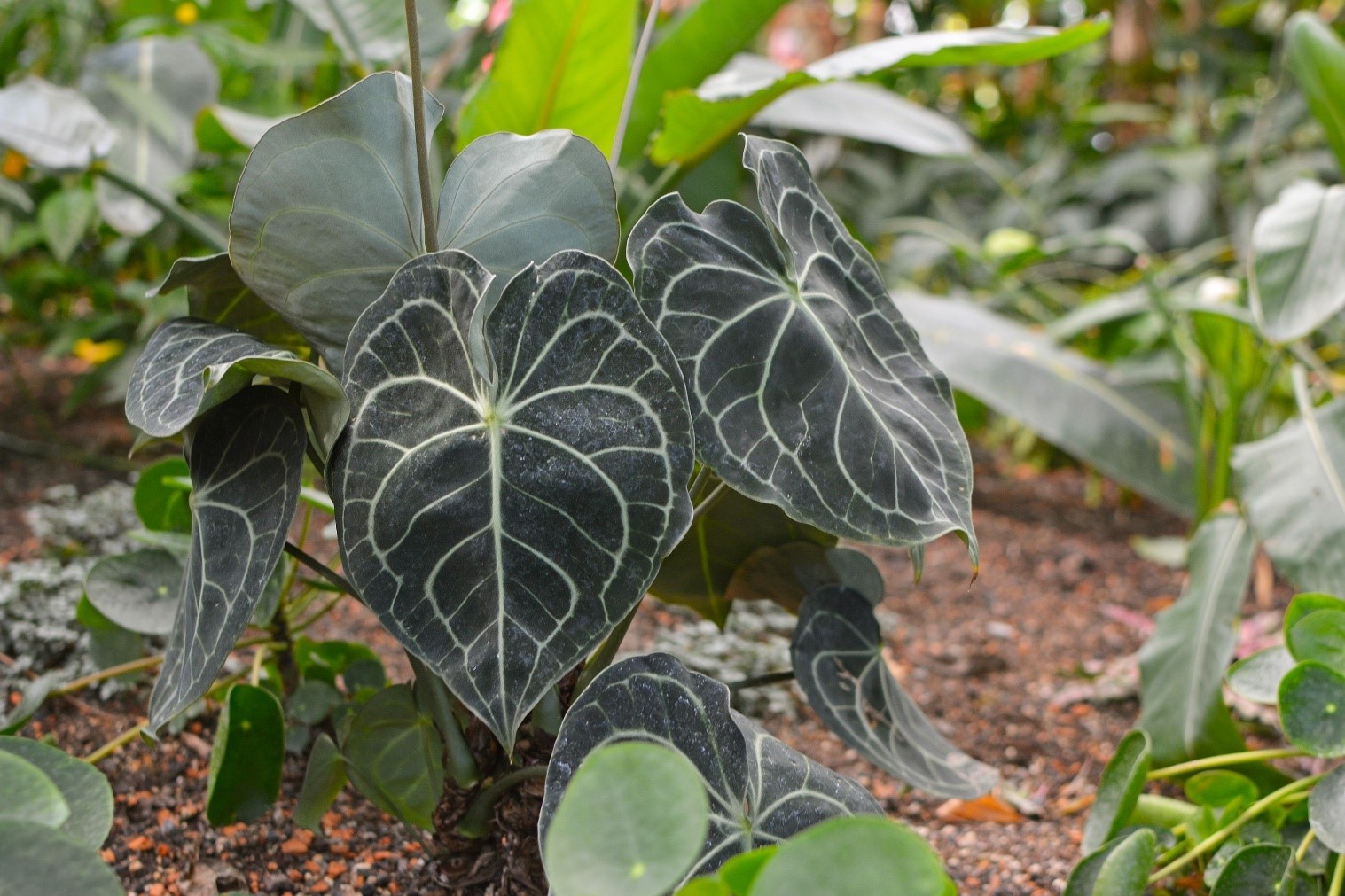
Anthurium Clarinervum is an epiphyte, which may grow on top of other plants or even tree trunks.
It belongs to the Araceae family of leaf plants.
Since it is native to southern Mexico, Anthurium Clarinervum is acclimated to hotter environments, but it may quickly adapt to cooler ones.
Its characteristics are broad, oval dark-green leaves with white veins that resemble the spades symbol from playing cards. It looks a lot like its near cousin, Anthurium Crystallinium, which is also quite lovely and easy to maintain.
The plant stems and leaves can be high and large, compared to other types of Anthurium, but this makes it perfect for growing indoors and makes it much easier to cultivate and maintain.
The Differences Between Anthurium Crystallinum and Clarinervium
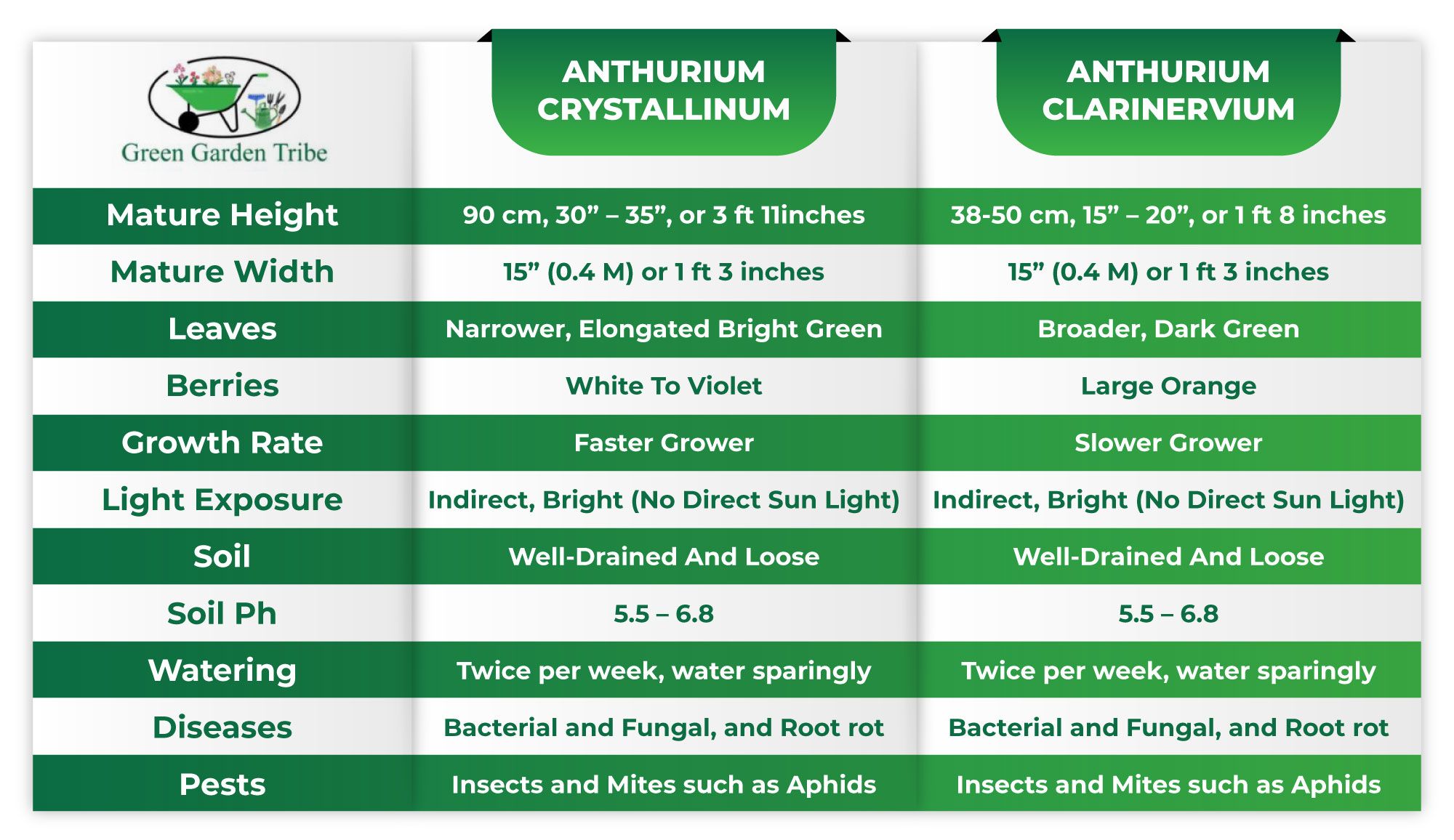
1. Their Difference Between Leaves, Berries, and Growth Rate
The leaves of these two Anthurium plants appear to be similar at first glance. They are both heart-shaped, although the heart is more noticeable on the Clarinervium, the Crystallinum’s leaves being more elongated.
An experienced botanist would immediately recognize the differences.
2. Anthurium Chrystallium Leaves
The first variance is that the leaves of Anthurium Crystallinum are thinner and more easily damaged.
Anthurium Clarinervium leaves have a darker color.
As a result, the Anthurium Crystallinum’s pattern is a little more vibrant.
Anthurium Crystallinum, has more elongated leaves; their length is about 10 cms or just under 4 inches.
Anthurium Crystallinum’s silver vein pattern is more textured than its competitor’s.
3. The Growth Rates – Chrystallinum
Its growth rate is not fast but if it has all the correct nutrients, it will not disappoint
The Anthurium Chrystallnum will reach a height of 90 cms, or 38-50cm, or 15-20 inches or 1 foot 8 inches
Anthurium Crystallinum’s silver vein pattern is more textured than its competitor’s.
There are also more buds and aerial roots on Anthurium Crystallinum. It makes it denser and multiplies more quickly.
This means that Anthurium Crystallinum is the plant to choose if you want a plant that grows swiftly and can be replicated quickly.
4. Anthurium Chrystallinum Berries
The color of the berries is the second criterion for identifying the Anthurium species.
Anthurium Crystallinum berries are white at first, but they turn purple as they grow.
Anthurium Crystallinum berries, conversely, have only one seed per berry.
Anthurium Crystallinum reproduces vegetatively,
5. Anthurium Clarivernum Leaves
Anthurium Clarinervium, has thicker (leathery) leaves that are more robust.
The heart shape of Anthurium Clarinervium is more noticeable.
Anthurium Clarinervium leaves have a darker color.
6. The Growth Rates: Clarivernum
Anthurium Clarinervium Grows Slower you can grow this plant indoors as it is easy to cultivate and requires less maintenance.
The average height of Anthurium Clarinervium is 38 to 50 cm , or 14.5 to 20.5 inches or 1 foot 2,5 inches – 1 foot 8.5 inches, with leaves of 8 to 10 cm or 3.15 to almost 4 inches in height.
The Anthuriums can be taller out in nature, but they are usually no more than 30 inches tall when inside a room. (Anthurium Clarinervium is slightly smaller). Their width can have a spread of approximately 15 to 20 inches.
Their rate of growth distinguishes them:
Anthurium Clarinervium’s slow growth and spreading have inevitable unintended consequences.
Adding this plant to your collection is a little more complicated. It’s also more expensive than Anthurium Crystallinum in most cases.
7. Anthurium Clarnervum – Berries
The mature Anthurium Clarinervium berries are orange at the same time.
The second distinction is that Anthurium Clarinervum berries are larger due to the presence of many seeds.
Finally, Anthurium Clarinervium produces more flowers and blooms more frequently. In other words, it creates more seeds than its cousin. Hence the reason for the species’ delayed growth.
Anthurium Clarinervium reproduces generatively.
Things that Anthurium Crystallinum and Clarinervium Share in Common
1. Soil Requirements
The soil requirements for both of these Anthuriums are nearly identical.
The first requirement is that the soil is well-drained. These are the jungle conditions in which these plants thrive. Their roots grow in the top layer of soil, where water isn’t trapped, or they attach themselves to the bark of giant trees.
The soil must also be loose.
Anthurium will struggle to grow in thick clay soil, and root rot is a possibility.
The acidity of the topsoil in which Anthuriums naturally grow is relatively high since it contains a lot of undecomposed plant leftovers.
As a result, these plants require slightly acidic soil (pH 5.5-6.8).
Mix 50 per cent sphagnum moss with 25 per cent perlite and 25 per cent bark to make soil that fits all standards.
The moss will add sponginess, the perlite will keep the appropriate moisture, and the bark will add acidity to the substrate.
You can also save time and money by purchasing orchid growing soil. It is ideal and does all the work for you.
2. Light Requirements
The Anthurium also has unique lighting requirements.
As previously said, this plant thrives under enormous trees and hence receives no direct sunshine.
However, this does not imply that it can be placed in complete darkness. The Anthurium may photosynthesize because of the canopy of tropical trees.
To ensure the best light balance, you should never set Anthurium Crystallinum or Anthurium Clarinervium in direct sunlight. That is, don’t put it in front of a window that faces south.
It’s best to put it on the sunny side of a window. It can also be placed in front of a window facing east or west. The most important thing is to provide at least six hours of indirect light to the plants.
3. Water Requirements
Both types require the same amount of watering.
When they are actively growing, from Spring to Fall, they require more water and should be watered once or twice a week during this period.
You may need to water three times a week if the summer is sweltering or if you live in the country’s south.
Anthuriums grow in such a way that when it doesn’t rain, the substrate dries up by nearly a quarter. A substrate is a layer of soil underneath. It’s the surface where a plant grows or is attached.
With your Anthurium in a pot, you should check the moisture content of the substrate with your fingers or a moisture meter and water the plant if it is 25% dry.
Root rot can be caused by overwatering. To avoid this, use pots that include drainage holes. It would be best if you don’t water more than once every 10-14 days during the dormant season of Winter. Water usage should be kept to a bare minimum.
4. Growing Conditions
Temperature
In the Winter, Anthuriums do not require as high a temperature as in the Spring or Summer. This doesn’t mean they’re tolerant of the cold.
They will be ruined and die if the temperature falls below 55 degrees Fahrenheit. So, during the Winter, rather not put them in a cold room.
Humidity
The humidity is the second issue. Anthurium Crystallinum and Anthurium Clarinervium do not survive dry air as well as other indoor plants.
Humidity should be between 55 and 65 per cent, with 75 and 85 per cent being optimal.
Humidifier
A humidifier should be put near the plant to create ideal conditions.
It isn’t a cheap solution, but it is rather convenient.
You could also spray the foliage at least once a day.
Finally, you can place a dish filled with water and stones beside the plant to help it dry.
5. Feeding
Nutrition
Nutrition is crucial in Anthurium life, but not as much as it is in the lives of other indoor plants.
Fertilizing
The first thing you should do after transplanting is to fertilize the plants. It’s essential not to use too much fertilizer.
It must have twice the phosphorus, potassium, and nitrogen content. Phosphorus will aid the plant’s development of a robust root system.
Spring to End of Summer
Then, from Spring to the end of Summer, apply a modest amount of fertilizer every 45 to 60 days.
During the Winter, there is no need to fertilize the plant.
There are lots of good fertilizers on the market. Some are made only for Anthuriums.
It’s your job to select the best option because economizing in this area can (and usually does) backfire.
Final Thoughts on Anthurium Crystallinum and Anthurium Clarinervium
The Anthurium Crystallinum and the Anthurium Clarinervum are both stately plants and beautiful to behold.
Originally hailing from Mexico, Argentina and the Caribbean, the Anthurium family are certainly exotic and most pleasing to the eye.
Considering the mystique and charisma of their past, these plants are relatively easy to maintain and make a striking statement.
There are many to choose from, although we are discussing only two of the varieties in this article.
Go and look at these exquisite plants and treat yourself to the one that attracts you the most. You’ll be glad you did!
Jenny Marie
Tribal Writer
Edited By
Patricia Godwin

